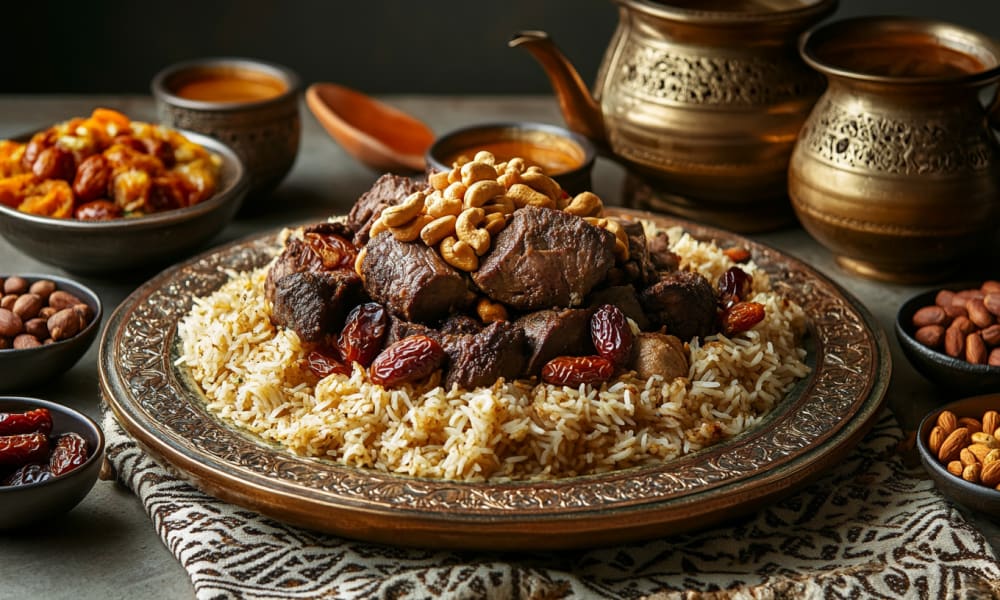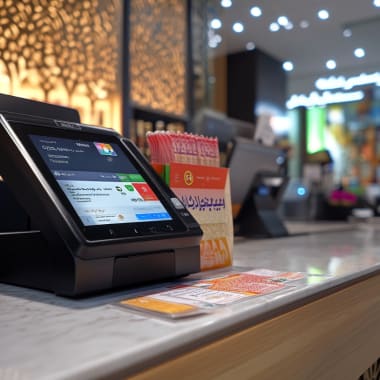
Culinary Highlights and Traditional Dishes in Saudi Arabia
From festive rice dishes to spicy street food classics – discover the diverse flavors of Saudi Arabia.
From festive rice dishes to spicy street food classics – discover the diverse flavors of Saudi Arabia.
Saudi Arabia is not only a land of impressive desert landscapes and thousands of years of history, but also a paradise for lovers of authentic cuisine. The traditional Saudi culinary culture is deeply rooted in regional customs, hospitality, and aromatic spices. Whether at a festive family meal or on the go in the market – culinary experiences are simply a part of Saudi Arabia. In this article, we will introduce you to four typical dishes and culinary traditions that you should definitely try on your travels.
Kabsa – The National Dish of Saudi Arabia
A fragrant rice dish that unites community, tradition, and hospitality.
More than just a dish: The cultural significance
Kabsa is much more than a popular rice dish – it is a symbol of Saudi identity, hospitality, and cultural connection. Served on large platters and traditionally eaten with the right hand, Kabsa represents community and togetherness. When family, friends, or guests sit together around the food, culinary experiences become a social occasion.
The dish is a staple of Saudi cuisine, both in everyday life and on special occasions. At celebrations such as weddings or Eid festivities, Kabsa is often prepared with a whole goat, underscoring the importance of the moment. At the same time, it is a popular everyday dish – especially at lunchtime in Saudi households.
Despite its nationwide popularity, there are numerous regional variations that differ in spices, ingredients, and preparation methods. Thus, Kabsa impressively showcases the culinary diversity of Saudi Arabia – while still maintaining a shared cultural bond.
The Taste of Saudi Arabia: Ingredients, Flavors, and Preparation
Kabsa is typically made from basmati rice and meat – usually chicken or lamb, but occasionally also goat, camel, beef, fish, or shrimp. Additional ingredients include vegetables like onions, tomatoes, and carrots, as well as a rich spice blend of cardamom, cinnamon, cloves, black lime (loomi), bay leaves, and nutmeg. Raisins or dried apricots add a slightly sweet touch.
The preparation takes place in a large pot: First, the meat is sautéed in oil, followed by the addition of spices, onions, and vegetables. The rice is mixed with the remaining ingredients and cooked in broth until it is soft and fully absorbs the aroma.
The taste of Kabsa is deep and complex – a warm, spicy combination with a slight acidity from the black lime. Cardamom and cinnamon impart an aromatic sweetness to the dish, while the juicy meat and fragrant rice provide a hearty base. Kabsa not only smells enticing but also leaves a lasting impression in terms of flavor.
Try it here! Tips for authentic enjoyment on site
Kabsa is found in all regions of the country – from the capital to the coast. A visit to Riyadh is particularly recommended, where restaurants like Al Romansiah, Shawaya House, Maiz, or Najd Village offer traditional and modern variants of Kabsa.
In Jeddah, Al Jazeera Mandi impresses with authentic Saudi cuisine, while Al Saddah and Hashi Basha are known for their Kabsa interpretations. The latter serves, among others, the special variant Nafar Kabsa Chicken.
These establishments not only offer delicious dishes but also an authentic atmosphere – from rustic-traditional to modern-Saudi. Those who try Kabsa in Saudi Arabia experience more than just a dish: It is a culinary access to the Saudi way of life.
Jareesh – Traditional Wheat Dish from the Najd Region
A hearty traditional dish with history – simple, nutritious, and deeply rooted in culture.
More than just a dish: The cultural significance
Jareesh is one of the most significant traditional dishes in Saudi Arabia – and not just on a daily basis. In 2023, it was officially declared the national dish of the country. Its origins date back to ancient Arabic cookbooks and it is closely linked to the regional identity, particularly the Najd region. In its local variant, Jareesh is often prepared with buttermilk and referred to as 'white Jareesh.'
Jareesh is served in various contexts: it is a staple at family meals, often served at weddings – typically the morning after the celebration – and plays an important role during Ramadan as a filling and nutritious dish. Additionally, Jareesh is essential during national holidays such as the Saudi National Day.
In various regions of Saudi Arabia, there are numerous preparation methods that reflect the diversity of Saudi cuisine. In Tabuk, Jareesh is often cooked with milk and wild ghee, while in Hail it is served with tomato sauce. These regional differences make the dish an exciting example of culinary creativity in practice.
The Taste of Saudi Arabia: Ingredients, Flavors, and Preparation
The base of Jareesh is cracked wheat, which is cooked with meat – usually lamb or chicken – along with onions, garlic, and a typical spice blend. The latter often consists of cumin, coriander, black pepper, and salt. The wheat is soaked while the meat is sautéed in a pan. Everything is then cooked together in broth until it reaches a creamy, nearly porridge-like consistency.
The taste of Jareesh is hearty and creamy, with a pleasant depth. In the version with buttermilk, it develops a slight sour note. In Hail, the addition of tomato sauce provides a mild sweetness and reddish color. In Tabuk, cooking with milk and wild ghee gives the dish a particularly rich flavor.
Jareesh is usually served with yogurt, salad, or pickled vegetables – side dishes that enhance the flavor of the dish and add extra freshness.
Try it here! Tips for authentic enjoyment on site
Anyone wanting to try Jareesh in its original form should definitely make a trip to the Najd region. In Riyadh, Najd Village is particularly recommended – a restaurant specializing in authentic Najdi cuisine. There are two locations in the city: on Takhassoussi Road and Abu Bakr Road. Also in Riyadh, the chain Al Romansiah serves traditional Jareesh of high quality.
A modern interpretation can be found at the restaurant Suhail, also in Riyadh. Here, Jareesh is refined with caramelized onions and ghee. Al-Saudi, known especially for Kabsa, also offers a solid version of the dish.
In addition to restaurants, the family home plays a central role as a culinary space. At special occasions, Jareesh is often prepared at home – anyone who gets the opportunity to participate in a traditional meal or receives an invitation experiences Jareesh in its most original form.
In Jeddah, a visit to the restaurant Tofareya is worthwhile, which offers not only Kabsa but also other traditional Saudi dishes – often including Jareesh.
Mutabbaq – Hearty Street Food Snack with Indian Roots
A folded delight with history – spicy, crispy, and at home on the streets of Saudi Arabia.
More than just a dish: The cultural significance
Mutabbaq – also known as Murtabak or Martabak – is a popular street food with an intriguing history: The Arabic name means 'folded' and refers to the typical preparation method where dough is artfully wrapped around a savory filling.
The origin of Mutabbaq is not clearly defined. Some sources trace it back to Yemen, while others see its roots in Kerala, India. It likely arrived in Saudi Arabia through trade routes and migration, where it gained great popularity, especially in the western Hejaz region. Today, Mutabbaq is not only found in Saudi Arabia but also in Southeast Asia – for instance, in Malaysia, Indonesia, or Singapore.
In Saudi Arabia, Mutabbaq is a staple in street food culture – especially during Ramadan, when it serves as a filling snack to break the fast. The filling of meat, eggs, and vegetables makes it nutritious, while its quick preparation makes it ideal for on-the-go eating. Whether at a street stand or in a small café: Mutabbaq is part of urban daily life and is an expression of the country's culinary diversity.
The Taste of Saudi Arabia: Ingredients, Flavors, and Preparation
Mutabbaq impresses with a crispy dough shell and a savory filling that varies slightly from region to region. Typical ingredients include:
- Minced meat (beef, lamb, or chicken), often seasoned with onions, tomatoes, cumin, and coriander
- Whisked eggs that add binding and juiciness to the filling
- Fresh vegetables such as spring onions, green peppers, and tomatoes
- Herbs and spices like parsley, black pepper, and salt
The preparation starts with a dough made of flour, water, and oil, which needs to rest until it is elastic. The filling is cooked separately in the pan. The dough is then rolled thin, filled, folded into a package, and fried until crispy.
In terms of flavor, Mutabbaq is hearty, spicy, and filling. Depending on the amount of spices, the heat can range from mild to pungent. In addition to the classic meaty versions, there are also creative fillings – such as cheese, shrimp, beans, or even sweet with nuts and honey. This makes Mutabbaq an extremely versatile dish for every taste.
Try it here! Tips for authentic enjoyment on site
Mutabbaq can be found at many street stands in Saudi Arabia, especially in large cities and traditional markets.
In Jeddah, a visit to the old town Al-Balad is worthwhile, where numerous stands offer fresh Mutabbaq. A true insider tip is Abu Zaid, known for its homemade variants and other local specialties like Masoub.
In Riyadh, Mutabbaq can also be discovered easily – for example, at the traditional Souk Al-Thumairi, where authentic street food is served in a lively atmosphere. Even in the holy cities of Mecca and Medina, Mutabbaq is a fixed part of the Iftar meals during Ramadan.
Other recommended addresses include Abu Hilal (especially popular in the Khobar region) as well as many street stands in Al-Balad, where the dish is freshly prepared before the guests' eyes.
Tip: The best Mutabbaq stands open early in the morning or in the evening when street life awakens. Engaging with locals often leads to personal recommendations that aren’t found in any guidebook. And: Don't hesitate to try several variants – from savory to sweet, each has its unique charm.
Saudi Coffee & Dates – Hospitality in Culinary Form
A time-honored ritual that is much more than a sweet snack and a strong drink.
More than just a dish: The cultural significance
In Saudi Arabia, genuine hospitality begins with a small cup of Qahwa and a few sweet dates. This combination is firmly rooted in Saudi daily and festive culture and is seen as a sign of respect, generosity, and social connection. When welcomed as a guest, one usually receives a cup of coffee first – accompanied by dates to balance the bitterness.
Qahwa, the Saudi coffee, is not simply served – its preparation and pouring follow clear rituals. The beans are lightly roasted and brewed with spices such as cardamom and saffron. The coffee is served from the Dallah, a traditional coffee pot, in small handleless cups, the Finjals. The host remains standing while pouring, while the guests sit – a sign of respect. The first cup is always given to the oldest or most esteemed guest.
It is also typical for the cups to be only half full – to leave room for multiple refills. A slight shake of the cup indicates that one has had enough. In addition to dates, nuts, dried fruits, or sweets are often served. This ritual symbolizes the Saudi understanding of politeness, mindfulness, and community.
The Taste of Saudi Arabia: Ingredients, Flavors, and Preparation
The Saudi coffee is made from Arabica mocha beans, often lightly roasted to allow the flavors of the added spices to fully develop. Typical ingredients include cardamom, saffron, and sometimes cloves or cinnamon – giving the coffee an intense, bitter-spicy aroma. Sugar or milk are traditionally not added, which makes the taste particularly strong.
The coffee is complemented by a selection of dates – a sweet balance to the bitterness of the drink. Among the many varieties, the following are particularly popular:
- Ajwa: Dark, mildly sweet, and rich in minerals.
- Sukkary: Golden with a caramel-like sweetness.
- Khodari: Slightly soft, pleasantly sweet, and ideal for daily consumption.
The interplay of bitter coffee and sweet dates is not only tastefully harmonious – it embodies the Saudi understanding of balance, tradition, and enjoyment.
Try it here! Tips for authentic enjoyment on site
Anyone wanting to authentically experience coffee and date culture will find impressive places throughout Saudi Arabia – from traditional cafés to cultural festivals.
Recommended cafés and locations:
- Diwaniya Expresses Coffee (Sakaka, Al-Jawf): A meet-up spot for families and friends with classic Qahwa and fresh dates.
- Jazean Experience Center (AlUla): Here, visitors experience coffee culture as part of the Saudi Coffee Company – including tastings, preparation, and stunning views of the landscape.
- Dallah Café (Riyadh): Known for its Bedouin style and authentic atmosphere.
- Beit Sitti (Jeddah): A charming café in the historic Al-Balad district – ideal for discovering local coffee specialties.
Cultural events and festivals:
- Al-Kharj Festival of Saudi Dates and Coffee: Especially worth experiencing during Ramadan – with many varieties, demonstrations, and offerings.
- Khawlani Coffee Festival (Jazan): An event for coffee harvesting in the mountainous regions – offering deep insights into cultivation and preparation.
- Saudi Coffee Week: Part of the Saudi Coffee Exhibition – here, the journey of coffee from the bean to the cup is impressively staged.
These locations make it clear: Qahwa and dates are more than just a culinary combination – they are lived culture, sensual experience, and an invitation to discover Saudi Arabia with all your senses.
Taste Meets Culture: A Journey for All Senses
Whether festive Kabsa, hearty Jareesh, spicy street food snack, or aromatic coffee with sweet dates – the culinary diversity of Saudi Arabia tells stories of tradition, hospitality, and regional identity. Anyone who engages with these flavors experiences not only good food but also a piece of Saudi living culture – authentic, deeply rooted, and unforgettable.
Discover the Orient with experts who have explored every corner themselves
Your dream holiday, tailor-made by experts.
We don't just know the Middle East from books, we visit the country several times a year to experience the culture, landscape and people first-hand.
From your first enquiry to your return home, we are there for you personally - by phone, email or WhatsApp, whenever you need us. Our trips are as unique as you are: individually planned and provided with exclusive privileges and high-quality arrangements that will make your trip unforgettable.
Experts for your Orient trip







